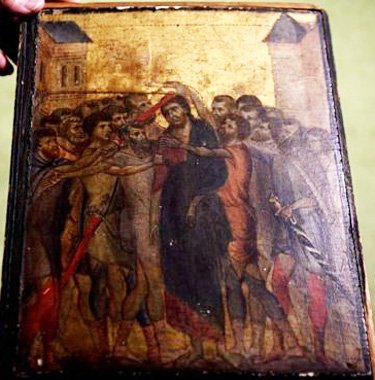Category Archive 'Painting'
25 Sep 2019


This painting by Cimabue had been hung above a hotplate in a kitchen in the French town of Compiegne.
BBC:
Christ Mocked, part of a series of paintings from the late 13th Century, was discovered at the property in the northern French town of Compiegne.
It is thought it could fetch up to €6m ($6.5m; £5.3m) at auction next month.
The woman had it valued believing it to be an old religious icon. Experts said there was “no disputing” its origin.
Tests were carried out on the artwork using infrared light to determine the similarities with works by the Italian painter Cimabue, also known as Cenni di Pepo.
“The painting was done by the same hand,” art expert Éric Turquin said, French newspaper Le Figaro reported.
It is believed to be part of a polyptych – a larger work of painted scenes divided into several panels – depicting Christ’s passion and crucifixion dating from 1280. …
In an interview with The Art Newspaper, Mr Turquin said that one of the clues to the painting’s origin lay in its panel.
“You can follow the tunnels made by the worms,” he said, referring to tracks in the panel made by wood-eating larvae similar to those found in other sections thought to be part of the same Cimabue artwork. “It’s the same poplar panel,” he added.
The painting, which the owner had hung above a hotplate in her kitchen, will be auctioned in France on 27 October.
12 Sep 2017


Smithsonian:
Anish Kapoor has long been known for his large-scale, intensely colored artworks, but his penchant for being proprietary has long irked others in the art world.
But then came Vantablack.
Earlier this year, Kapoor sparked outrage from artists all over the world with the announcement that he had made a deal to become the only person in the world allowed to use the blackest pigment of black paint ever developed. Known as Vantablack, the unique carbon nanotube-based pigment is produced solely by a British company called NanoSystem, and was originally developed for military technologies. However, Kapoor made an agreement with the company that he is the only person allowed to use it for artistic purposes.
Needless to say, that made plenty of other artists furious.
“When I first heard that Anish had the exclusive rights to the blackest black I was really disappointed,” artist Stuart Semple tells Kevin Holmes for The Creators Project. “I was desperate to have a play with it in my own work and I knew lots of other artists who wanted to use it too. It just seemed really mean-spirited and against the spirit of generosity that most artists who make and share their work are driven by.â€
Like Kapoor, Semple’s work often uses vivid shades of color, and for years he had worked with scientists to develop increasingly intense pigments to use in his artwork. So as a response to Kapoor’s exclusive deal with Vantablack, Semple decided to release his own special pigment, known simply as “Pink,†the Irish Examiner reports.
While “Pink†isn’t based on nanotechnology, like Vantablack, Semple says it is the pinkest pink pigment ever created. Now, in an effort to thumb his nose at Kapoor, Semple is making it for sale to everyone in the world—except Kapoor.
RTWT
13 Jul 2008


Horses & rhinos from Chauvet Cave
You can’t read this excellent article by Judith Thurman, biographer of Isak Dineson, on the Paleolithic cave art of Southern France at the New Yorker web-site, but you can read it via Art & Letters Daily. Go figure.
We don’t know the purpose for which the images were made. We don’t understand why Paleolithic artists almost entirely avoided the depiction of human beings. But we marvel at their representational accuracy and their ability to move us emotionally across a separation of tens of thousands of years of time.
During the Old Stone Age, between thirty-seven thousand and eleven thousand years ago, some of the most remarkable art ever conceived was etched or painted on the walls of caves in southern France and northern Spain. After a visit to Lascaux, in the Dordogne, which was discovered in 1940, Picasso reportedly said to his guide, “They’ve invented everything.†…
(The) earliest paintings (at Lascaux) are at least thirty-two thousand years old, yet they are just as sophisticated as much later compositions. What emerged with that revelation was an image of Paleolithic artists transmitting their techniques from generation to generation for twenty-five millennia with almost no innovation or revolt. A profound conservatism in art, (Gregory) Curtis notes, is one of the hallmarks of a “classical civilization.†For the conventions of cave painting to have endured four times as long as recorded history, the culture it served, he concludes, must have been “deeply satisfyingâ€â€”and stable to a degree it is hard for modern humans to imagine.
Read the whole thing.
/div>

Feeds
|






